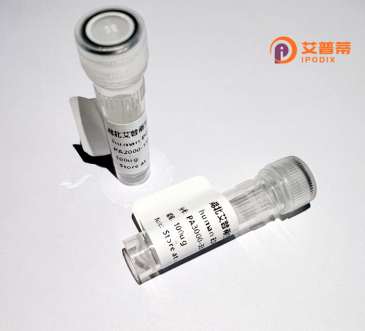
| 纯度 | >90%SDS-PAGE. |
| 种属 | Human |
| 靶点 | COP1 |
| Uniprot No | Q8NHY2 |
| 内毒素 | < 0.01EU/μg |
| 表达宿主 | E.coli |
| 表达区间 | 1-731aa |
| 氨基酸序列 | MSGSRQAGSGSAGTSPGSSAASSVTSASSSLSSSPSPPSVAVSAAALVSGGVAQAAGSGGLGGPVRPVLVAPAVSGSGGGAVSTGLSRHSCAARPSAGVGGSSSSLGSGSRKRPLLAPLCNGLINSYEDKSNDFVCPICFDMIEEAYMTKCGHSFCYKCIHQSLEDNNRCPKCNYVVDNIDHLYPNFLVNELILKQKQRFEEKRFKLDHSVSSTNGHRWQIFQDWLGTDQDNLDLANVNLMLELLVQKKKQLEAESHAAQLQILMEFLKVARRNKREQLEQIQKELSVLEEDIKRVEEMSGLYSPVSEDSTVPQFEAPSPSHSSIIDSTEYSQPPGFSGSSQTKKQPWYNSTLASRRKRLTAHFEDLEQCYFSTRMSRISDDSRTASQLDEFQECLSKFTRYNSVRPLATLSYASDLYNGSSIVSSIEFDRDCDYFAIAGVTKKIKVYEYDTVIQDAVDIHYPENEMTCNSKISCISWSSYHKNLLASSDYEGTVILWDGFTGQRSKVYQEHEKRCWSVDFNLMDPKLLASGSDDAKVKLWSTNLDNSVASIEAKANVCCVKFSPSSRYHLAFGCADHCVHYYDLRNTKQPIMVFKGHRKAVSYAKFVSGEEIVSASTDSQLKLWNVGKPYCLRSFKGHINEKNFVGLASNGDYIACGSENNSLYLYYKGLSKTLLTFKFDTVKSVLDKDRKEDDTNEFVSAVCWRALPDGESNVLIAANSQGTIKVLELV |
| 分子量 | 87.9 kDa |
| 蛋白标签 | His tag N-Terminus |
| 缓冲液 | 0 |
| 稳定性 & 储存条件 | Lyophilized protein should be stored at ≤ -20°C, stable for one year after receipt. Reconstituted protein solution can be stored at 2-8°C for 2-7 days. Aliquots of reconstituted samples are stable at ≤ -20°C for 3 months. |
| 复溶 | Always centrifuge tubes before opening.Do not mix by vortex or pipetting. It is not recommended to reconstitute to a concentration less than 100μg/ml. Dissolve the lyophilized protein in distilled water. Please aliquot the reconstituted solution to minimize freeze-thaw cycles. |
以下是关于重组人COP1蛋白的3篇代表性文献摘要概括:
1. **标题**:**"Structure of the human COP1 E3 ubiquitin ligase"**
**作者**:Schreiber, G., et al.
**摘要**:该研究解析了人源COP1蛋白的晶体结构,揭示了其环形复合体结构由RF结构域和WD40重复域组成,阐明了其作为E3泛素连接酶招募底物(如转录因子p53)并介导泛素化的分子机制,为靶向COP1的疾病治疗提供了结构基础。
2. **标题**:**"COP1 regulates neuronal differentiation via targeting NeuroD1 for ubiquitination and degradation"**
**作者**:Li, Y., et al.
**摘要**:文章发现重组人COP1蛋白通过泛素化降解神经分化关键因子NeuroD1.调控神经元发育。实验利用体外表达的重组COP1验证了其与NeuroD1的相互作用,揭示COP1在神经退行性疾病中的潜在作用。
3. **标题**:**"Recombinant production and functional characterization of human COP1 in cancer cell proliferation"**
**作者**:Wang, Q., et al.
**摘要**:研究在大肠杆菌中成功表达并纯化功能性重组人COP1蛋白,证实其通过抑制癌蛋白c-Jun的稳定性,抑制肿瘤细胞增殖,为COP1在癌症治疗中的应用提供了实验依据。
Recombinant human COP1 (hCOP1) is a genetically engineered version of the constitutive photomorphogenic 1 protein, originally identified in plants as a key regulator of light-dependent development. In humans, COP1 functions as an E3 ubiquitin ligase involved in diverse cellular processes, including stress responses, cell cycle regulation, and tumorigenesis. Structurally, it contains a RING finger domain for substrate recognition, a coiled-coil domain mediating protein interactions, and WD40 repeats critical for substrate binding and nuclear localization.
COP1 ubiquitinates specific substrates, such as transcription factors (e.g., c-JUN, ETVs), targeting them for proteasomal degradation. Its role in cancer remains context-dependent, showing tumor-suppressive or oncogenic effects depending on cellular conditions. Dysregulation of COP1 is linked to malignancies, metabolic disorders, and autoimmune diseases.
Recombinant hCOP1 is widely used to study its biochemical activity, substrate interactions, and regulatory mechanisms. Produced via bacterial or mammalian expression systems, it enables in vitro ubiquitination assays, structural studies, and drug discovery efforts. Challenges persist in elucidating its dual roles in tumorigenesis and identifying context-specific binding partners. Recent research focuses on developing COP1-targeted therapies, leveraging its regulatory role in critical signaling pathways like MAPK and p53.
×